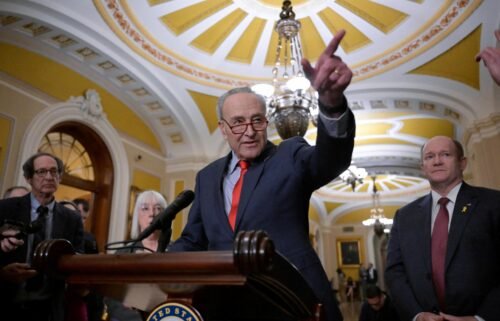The terrified Kashmir families who call one of the world’s most militarized zones home

Brightly-colored houses are pock-marked and cracked in Jura, a town of about 6,000 people in Pakistani-administered Kashmir.
Shops and walls are scorched black, and pieces of metal and chairs lie in twisted, dirty piles, the remnants of Indian shelling more than a week ago, Pakistan says.
Standing outside a damaged tea kiosk in Jura bazaar with her young son, Maroofa Bibi said she lives in “constant fear.”
“When the shelling starts, we rush to cower in the makeshift basements of our home,” she told CNN. “The power supply gets cut and we wait in the darkness with our terrified children, waiting for it be over.”
CNN traveled to Jura on Tuesday as part of a heavily guarded media and diplomatic visit organized by the Pakistani military. Pakistan wanted to show the damage it says was inflicted by shelling on October 20. India says villages on its side of the militarized line that divides Indian- and Pakistani-controlled Kashmir were damaged, too.
This year alone, Pakistan says India has violated a ceasefire agreement by firing upon or shelling its territory thousands of times. However, an Indian government source claims all ceasefire violations this year were committed by Pakistan.
Small towns along the militarized line that divides Indian and Pakistani-controlled Kashmir are on the frontline of ongoing tensions over the disputed region. On both sides of the border, shelling has ruined buildings and driven families from their homes.
A decades-old dispute
For more than 70 years, people living in the disputed Muslim-majority region of Kashmir have been separated by a ceasefire line that is now called the Line of Control. Once regarded as temporary, it’s since become a heavily guarded de facto border that separates the two parts of Kashmir.
After their partition at the end of British rule in 1947, both India and Pakistan claimed the state of Jammu and Kashmir in its entirety. And since then, it’s become one of the most militarized regions of the world as the nuclear-armed neighbors continue to engage an often-violent struggle over the region.
In recent months, tensions have increased. In August, India revoked Jammu and Kashmir’s semi-autonomous status and imposed an almost-complete communications black-out for more than two-and-a-half months.
Travel curfews and roadblocks were put in place, and millions of residents in India’s only Muslim-majority region were cut off from their families in other parts of the country. Officials in Indian-controlled Kashmir told of mass detentions, while residents said tear gas and pellet guns were used against Kashmiri citizens.
India said the move to revoke the status was to ensure the nation’s laws were equal for all citizens and to increase economic development in the region, as well as to end separatism and terrorism it alleged was aided and abetted by Pakistan.
Pakistan has denied those charges, saying its backing for the Kashmiri struggle is a moral one.
New Delhi’s move also prompted anxiety among the region’s Muslim population who are afraid that the government is trying to change the demographics of the region as part of a plan to establish a Hindu nationalist nation.
A deadly day of violence
India and Pakistan most recently agreed to a ceasefire in border regions in November 2003, but the agreement has been repeatedly violated. This year alone, India has fired and shelled in the border regions 2,608 times, leaving 44 civilians dead and another 230 injured, according to Pakistan military spokesperson Major General Asif Ghafoor.
However, an Indian government source said there had been 2,500 ceasefire violations in 2019, all initiated by the Pakistan Army.
On October 20, Pakistan and India once again exchanged fire, making it one of the deadliest days since New Delhi revoked Kashmir’s special status.
India said two Indian soldiers and one civilian died. Indian Army chief Bipin Rawat said India had managed to significantly damage terrorist camps in Pakistani- controlled Kashmir, killing six to 10 Pakistani soldiers and about the same number of terrorists.
Rawat alleged that Pakistan was sheltering terrorists, and said Pakistan didn’t want to highlight the damage that India claims to have inflicted as the “world will know that there is no action being taken to curtail the acts of terrorism.”
Pakistan, meanwhile, said five civilians were killed and six others injured in what it called “indiscriminate and unprovoked firing” from India. Pakistan hit back at India’s claims that it was targeting terror camps and denied that it was harboring terrorists.
Both sides accused the other of starting the gunfire and shelling. And on both sides, residents are left to deal with the damage from the ongoing tensions.
The people living in fear
The Himalayan town of Jura sits in the Neelum Valley, just 4 kilometers (2.5 miles) from the de facto Indian-Pakistani border.
To get to the remote town from the country’s capital Islamabad, one must take a two-hour helicopter and bus ride over rolling hills and lush, emerald green vales — a visual reminder that this area of ongoing, sometimes violent disputes was once called “Paradise on Earth.”
But on Tuesday, Jura looked like it had been hit by an earthquake.
Small and large holes dotted the walls of houses where chunks of plaster appeared to have been blasted out. Pakistan military spokesman Ghafoor said those were all signs of the October 20 violence.
“I lost half my livelihood in one night,” said Pir Zada Qasim Shah, standing by the charred façade of his furniture and mattress store. Inside, his wares were strewn everywhere.
As the military-organized tour moved through the town, a small crowd of villagers trailed behind them, calling out praise for the Pakistani army and cursing India’s Prime Minister Narendra Modi.
A representative from China — which has avoided making strong comments on the conflict between India and Pakistan — was also on the Pakistan-arranged visit. Yao Jing, the Chinese ambassador to Pakistan, told CNN that the rise of unilateral action on the border was worrying and that he hoped both sides could come to a dialogue to ease the suffering of Kashmiri people.
China is also a significant stakeholder in the Kashmir dispute between India and Pakistan, having its own claim on the Kashmiri region of Aksai Chin along the Indian-Chinese border.
But Jura is not the only border town to be hit.
Across the Neelum Valley, which is home to about 191,000 people, other towns were also targeted in the October 20 strikes. Around 60% of the inhabitants of Sharda, a village northwest of Jura, were forced to evacuate over the weekend, according to the Pakistan military.
Three of the people who were believed to have been killed by Indian fire in the deadly day of shelling were members of the same family in Nousehri, a village by the Neelum-Jhelum hydropower project around 40km or 25 miles from Muzaffarabad, the capital of Pakistani-administered Kashmir.
Hajra Bibi said her husband, son and a cousin were killed in the strike as they sheltered in a tunnel. “We dragged the bodies into the tunnel and sat with them all night because we were too afraid to get out,” Bibi said. “We weren’t even able to tell the rest of the family what happened.”
Family member Tariq Mir said they had opted not to hold a proper funeral for the men because they worried they could come under attack by Indian forces. He said Nousehri villagers began fleeing to cities or the mountains for safety. “Our village has begun to empty out,” he said.
Life in Indian-controlled Kashmir
Indian-controlled Kashmir is only kilometers away from Nousehri but getting there requires scaling a Himalayan mountain range and passing through a heavily militarized border.
“There is silence and fear here,” said Farooq Bigh, a council leader and resident of Uri, one of the most volatile areas in Indian-controlled Kashmir which is close to the Line of Control. “When their shells come, we don’t know how many will come and where they will land.”
In Uri, schools are inaccessible for most as buses aren’t running, Bigh said.
In the Kupwara region north of Uri, a few houses were damaged in the recent shelling, according to the area’s deputy commissioner, Anshul Garg. He has sent a request to the Indian government for another 14,000 public bunkers to be constructed. India’s Ministry of Defence declined to comment when asked about the request.
Why the ceasefire violations occurred
As with the death toll and the ceasefire violations, there is no agreement between India and Pakistan about what prompted the deadly attacks earlier this month.
In a briefing during the organized media trip Tuesday, Pakistan military spokesman Ghafoor said Pakistan does not target civilians.
Instead he claimed the current rise in hostilities was an attempt by India to distract from the plight of those living under curfew in Indian-controlled Kashmir.
India dismissed Pakistan’s claims.
On Tuesday, Rajnath Singh, India’s defense minister, told reporters that India had never been on the offence. “India has never attacked another country and nor has laid claim to even an inch of land in any other country,” he said.
“But the Indian Armed Forces are capable and strong. Whomsoever looks at India with bad intentions, then we will give a befitting reply.”

